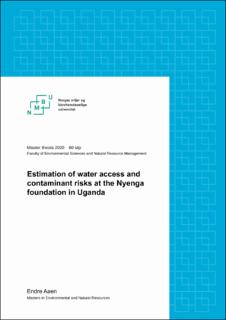| dc.contributor.advisor | Kitterød, Nils-Otto | |
| dc.contributor.advisor | Kayendeke, Ellen Jessica | |
| dc.contributor.author | Aaen, Endre | |
| dc.coverage.spatial | Uganda, Nyenga | en_US |
| dc.date.accessioned | 2020-09-10T12:02:03Z | |
| dc.date.available | 2020-09-10T12:02:03Z | |
| dc.date.issued | 2020 | |
| dc.identifier.uri | https://hdl.handle.net/11250/2677262 | |
| dc.description.abstract | Nyenga foundation is a voluntary foundation located on the outskirts of Nyenga village in Uganda. The foundation is running a medicine center, a primary school and are working with engaging the local community in the making of jobs and stimulating local economy.
The area around Nyenga foundation consists of wetlands and rainforest. The main land use is for agriculture use with production of banana, cassava, sweet potatoes, and rice. The water supply of Nyenga foundation is, as big parts of Uganda, based on groundwater from shallow wells and enhanced natural springs. Groundwater is often seen as one of the safest sources of clean fresh water but a lack of education in hygiene and understanding of water dynamics and hydraulics makes shallow water supplies in risk of local pollution.
This thesis use analysis of pumping tests to estimate the yield in the well of Nyenga foundation and doing a risk analysis of the water in the local well. The risk analysis was based on bacteriologic transport, with a hygienization time of 60 days. The pumping test analytic methods used were Theis method, Jacobs method and Boulton-Streltsova curve fitting method. The pumping tests used for analysis was done 29th October to 9th November 2020. This was in a period of unusual heavy precipitation leading up to the time of pumping tests. The results from the tests are therefore seen as the maximum water yield from the well.
The pumping tests had a drawdown of about 5cm. The drawdowns were quite consistent over 4 pumping tests with different durations due to problems with pump failures. Because of a lack of geological data in form of aquifer depth and lack of observation wells, combined with a small drawdown, we had to make some extra assumptions for the analysis. After comparing the results from the pumping tests and field conditions, a storativity (S) of 0.02-0.04 and a hydraulic conductivity (K) of 2*10-5m/s were estimated. This gave an estimated water yield from the well at Nyenga foundation of 1350-1550 l/h When using this data combined with elevation data and climatic data, risk distances and flow patterns were calculated. The area with high risk of contaminants were set to 10m after adjusting the theoretical area of 2m to account for uncertainties. A max area of influence was estimated to 208 m.
The thesis concludes that the largest contaminant risk comes from local contamination in form of bacteria from feces. This is especially a risk in the area closest to the well. Measures are therefore to stop holding livestock in the area closest to the well. | en_US |
| dc.description.sponsorship | Ingeniører uten grenser, Stiftelsen Nyenga | en_US |
| dc.language.iso | eng | en_US |
| dc.publisher | Norwegian University of Life Sciences, Ås | en_US |
| dc.rights | Attribution-NonCommercial-NoDerivatives 4.0 Internasjonal | * |
| dc.rights.uri | http://creativecommons.org/licenses/by-nc-nd/4.0/deed.no | * |
| dc.subject | Drinking water | en_US |
| dc.subject | Water supply | en_US |
| dc.title | Estimation of water access and contaminant risks at the Nyenga foundation in Uganda | en_US |
| dc.type | Master thesis | en_US |
| dc.description.version | submittedVersion | en_US |
| dc.subject.nsi | VDP::Mathematics and natural science: 400 | en_US |
| dc.source.pagenumber | 50 | en_US |
| dc.description.localcode | M-MINA | en_US |

